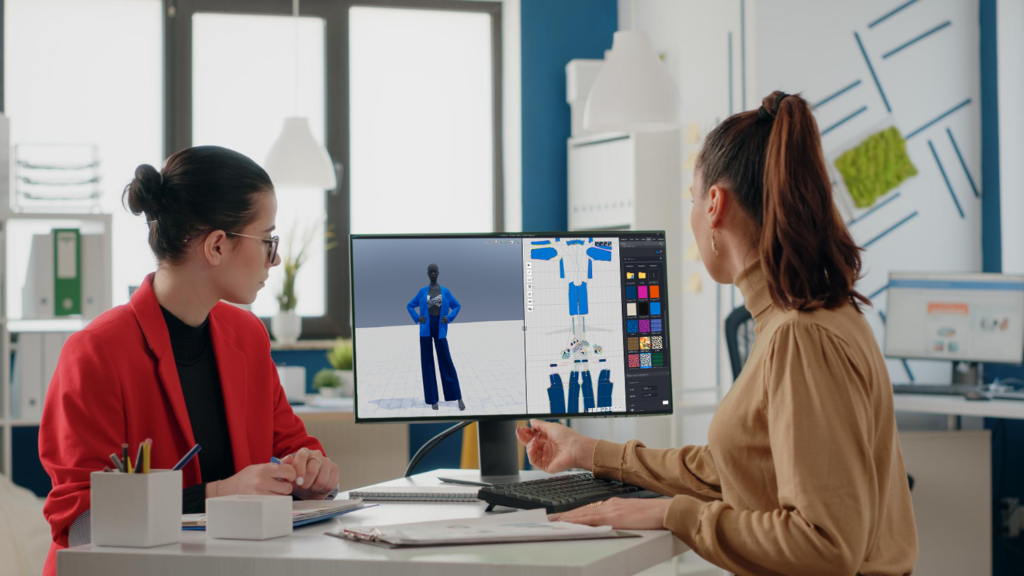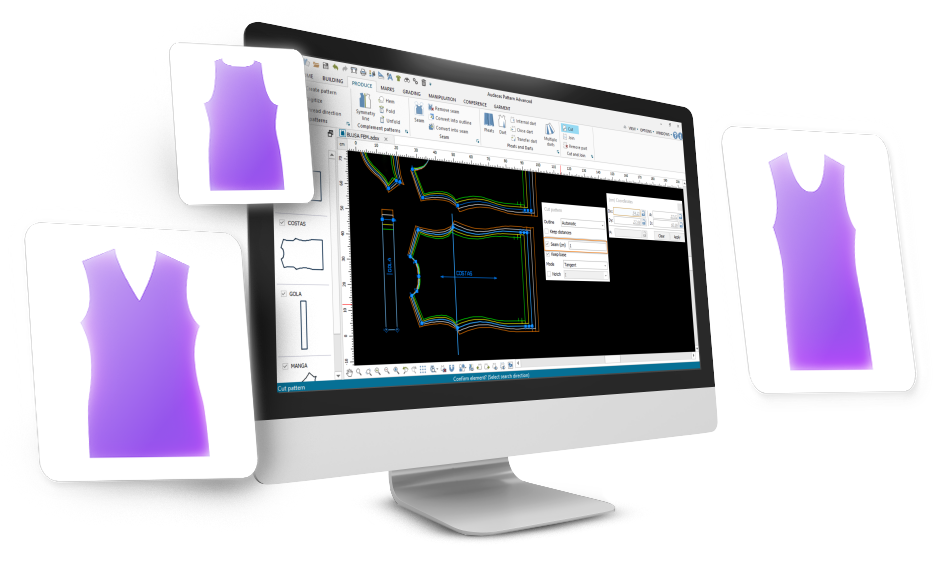Summary
- Pattern making is the key principle to ensuring a good fit for any type of garment.
- Effective clothing pattern design can be the decisive factor for a successful collection.
- Audaces360 offers cutting-edge technology tools to ensure precise work. Try it for free!
Accurate patterns are essential for clothes that fit well and feel comfortable. They ensure garments drape smoothly on the body and meet consumers’ expectations.
Poorly fitting clothes, caused by inexact design, can be uncomfortable, restrict movement, and look unflattering. And this can become a major problem for fashion companies, which need to ensure sales success.
It doesn’t matter if you buy commercial patterns, download them digitally, or draft them from scratch. One thing is certain: you need to know the basic principles, and that’s why we’ve prepared this guide.
Enjoy your reading!
Sumário
Why make more precise clothing pattern designs?
It’s the first step to creating garments that fit well and look their best. Precise patterns ensure clothes fit comfortably and move naturally with the body.
They play a major role in the entire production process, from prototyping to collection approval, marking, cutting, and sewing.
Efficient patterns streamline manufacturing, making each stage more effective. The attention to detail in clothing pattern design and pattern grading not only enhances quality. It also reduces costs by minimizing fabric waste.
Keep it in mind: this level of skill demonstrates professionalism in the fashion industry, where every detail matters.
Learn more: What is the best way to create a pattern of clothing?
What is clothing pattern design?
Clothing pattern design is the process of creating a template, used to cut and sew fabric into a garment. You can make this template manually or digitally, with digital methods generally offering greater consistency and accuracy.
Patterns pieces outline the shapes and sizes of each part that make up a complete piece of clothing. They must include details such as seam allowances, darts, pleats, and other design elements.
Some fashion design professionals specialize in this stage of the process. Pattern makers use technical knowledge to guarantee that the finished garment fits well, drapes properly, and achieves the desired look.
They are important to any apparel manufacturing process, earning them well-deserved recognition within the market.
Learn more: Explore clothing pattern making techniques for your production
3 basic principles of clothing pattern design
Although clothing pattern design may seem daunting, some basic principles serve as valuable guides. Some basic principles let pattern makers make better clothes — less waste, perfect fit, and styles customers love!
1) Measurements and proportions
Getting garment sizes just right starts with knowing bodies. We need to measure things carefully, like chest, waist, hips, and height. But it’s not just about numbers.
Different body shapes have different proportions, like torso length compared to leg length. Understanding this helps create patterns that fit well and look good on everyone.
Pattern makers must also consider how fabrics drape over various body shapes. Fabrics behave differently over curves and angles, affecting the appearance and comfort.
Taking these factors into account helps create patterns that fit well and enhance the natural contours of the body.
Learn more: 6 pattern making tools every fashion designer should use
2) Baselines
baselines serve as the framework upon which we construct the pattern. These lines, straight or curvy, represent key reference points for the placement of other pattern elements. They include darts, seams, and armholes.
Ensuring the accuracy and consistency of these baselines is essential for creating a basic pattern. Once you ensure it aligns with the body’s natural contours and ensures a proper fit, you can reuse it.
To save time and effort, it can serve as a base pattern for other designs. Just add the details you want to these basic blocks, so you don’t have to start from scratch.
Learn more: 10 Pattern making and marking challenges
3) Necessary markings

Markings, such as notches, darts, and seam lines, provide crucial instructions for assembling the garment. These markings serve as visual cues for the sewer, to guide them.
They enable precise alignment of pattern pieces and ensure the correct placement of seams and other construction details. That’s why people call the finished clothing pattern design a sewing pattern.
In short, precision in these markings is essential for achieving a seamless and professional-looking garment.
Learn more: Advantages of using free sewing patterns and where to find them
How to ensure quality with efficient clothing pattern design?
Here’s a summary with valuable tips on how to ensure quality when creating your clothing pattern design. You can refer to it whenever you need them:
- Accurate measurements: Begin with precise body measurements to create patterns that fit well across different sizes.
- Consistent baselines: Maintain consistent baselines to ensure proper placement of darts, seams, and other elements.
- Testing and iteration: Prototype patterns to identify and correct any fitting issues before final production.
- Material optimization: Minimize fabric waste by strategically placing pattern pieces on the fabric.
- Attention to detail: Check and double-check pattern accuracy to avoid errors. They could affect garment fit and quality.
Learn more: Understand the importance of a pattern maker for fashion manufacturing
How can technology streamline the work of a pattern maker?
Technology enhances productivity, accuracy, and collaboration in pattern making, enabling pattern makers to work more efficiently and effectively in the fashion industry.
Still, it’s important to remember that technology is a tool that complements a pattern maker’s expertise.
Skilled pattern design clothes creators are still essential. They must interpret designs, understand fabric properties, and ensure a flawless final product.
Discover how technology can assist you in creating clothing pattern design:
Enabling collaborative creation

Collaborative creation is possible through digital software. It enables multiple users to work on a pattern together, if necessary, no matter where they are. When one person makes changes, everyone sees them in the file.
Version control is possible through tools that track changes. This way, teams can easily revert to previous versions if needed. It helps prevent confusion and ensures everyone works on the latest iteration of the pattern.
Integrating with other software
Integration improves workflow by cutting manual data entry and transfers between different programs. Pattern data moves seamlessly from one software to another, saving time and reducing errors.
For instance, patterns can easily move to a CAD system for marking. This direct transfer eliminates the need to recreate patterns in different formats, ensuring effective operations.
In addition, you can add your clothing pattern designs to a PLM (Product Lifecycle Management). This enables you and your team to manage product data, revisions, and collaboration across different stages of collection development.
Automatically grading
It offers significant benefits to pattern makers. Firstly, it eliminates the need for manual grading, where you must create patterns for each size from a base pattern.
This process can be tedious and time-consuming, especially for garments with intricate shapes. Automatic grading automates this task, saving valuable time for pattern makers to focus on more creative aspects of their work.
Furthermore, automatic grading enhances accuracy and consistency in pattern sizing with just a few clicks. It also facilitates faster production of different size samples, expediting the design and development process.
This can help you meet deadlines and create a broader range of sample sizes for fit testing, streamlining the production workflow.
Simulating the finished garment
Simulating the finished garment in 3D and testing pattern pieces on software is a great advantage to pattern makers.
You can visualize how the garment will look and fit on a virtual mannequin before creating a physical sample. This helps save time and materials by identifying potential issues early in the design process.
Digital solutions foster collaboration and communication among pattern makers, designers, and manufacturers. The team can discuss changes and improvements in real-time, leading to better decision-making.
It translates to fewer errors during production, thus reducing costs associated with material waste.
Learn more: 5 benefits of 3D modeling software in your apparel company
Create more precise and effortless patterns 100% digitally

Exploring the possibilities that technology offers is essential for developing clothing patterns and standing out in the fashion industry.
Discover the solutions offered by Audaces, a global reference in fashion technology.
Audaces Pattern
For pattern makers looking for excellence, Audaces Pattern is an essential solution. It ensures the pattern of clothing creation reaches a new level of efficiency and precision.
With its dynamic and versatile approach, it is possible to develop high-quality patterns, regardless of complexity. Refine every detail to perfection, ensuring that your creative vision translates into patterns.
This important ally will help you in your journey toward success in the fashion industry. It will give you the confidence to stand out in the market!
Audaces 3D
Audaces 3D is the essential solution for pattern makers to bring creations to life in a three-dimensional mannequin.
With a range of tools and possibilities, this software transforms the creative and development processes. Paper patterns of clothing days will soon be in the past!
Test your digital pattern before creating a physical sample. This helps save time and resources by identifying issues early in the process.
Additionally, it enables you to shape your ideas directly in a digital environment, gaining agility and quality in deliveries.
Are you a pattern maker looking to take your skills to the digital level? Learn how Audaces can streamline and elevate your work!
Download our free e-book and discover how digital modeling works in our system!
FAQ
It’s the first step to creating garments that fit well and look their best. Precise patterns ensure clothes fit comfortably and move naturally with the body.
Clothing pattern design is the process of creating a template, used to cut and sew fabric into a garment.
Measurements and proportions, baselines, and necessary markings.










